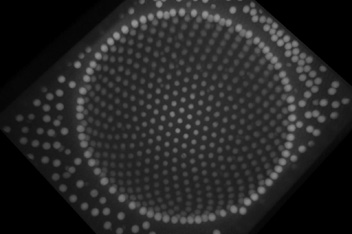Home > Press > Physicists grow pleats in two-dimensional curved spaces
 |
| University of Chicago physicist William Irvine and his colleagues are interested in how the interplay of geometry and light affect the structure of two-dimensional curved spaces, including those of a sphere (shown here), but also domes, waists and barrels. The team has developed methods for finely controlling pleats in these curved spaces, which may be useful in the design of nanoscale materials. (William Irvine) |
Abstract:
A design feature well known in skirts and trousers has now been identified in curved, two-dimensional crystals. As University of Chicago physicist William Irvine and his colleagues report in this week's Nature, crystalline arrays of microscopic particles grown on a negatively curved surface can develop linear defects analogous to fabric pleats. The results will facilitate a more general exploration of defects in curved spaces, including potential applications in engineered materials.
Physicists grow pleats in two-dimensional curved spaces
Chicago, IL | Posted on December 24th, 2010The problem of tiling a curved surface with hexagons is familiar from soccer balls and geodesic domes, in which pentagons are added to accommodate the spherical (positive) curvature. Interacting particles that form hexagonal patterns on a plane — known as ‘colloidal crystals' — adopt these and other types of topological defects when grown on a sphere.
Irvine, an assistant professor in physics, and colleagues have developed an experimental system that allows them to investigate crystal order on surfaces with spatially varying curvature, both positive and negative. On negatively curved surfaces, they observed two types of defect that hadn't been seen before: isolated heptagons (analogous to the pentagons on a sphere) and pleats.
The pleats allow a finer control of crystal order with curvature than is possible with isolated point defects, and may find application in curved structures such as waisted nanotubes (long, thin microscopic cylinders of material that display novel properties), or in materials created by techniques that permit control at the atomic and molecular levels, such as soft lithography or directed self-assembly.
Citation: "Pleats in crystals on curved surfaces," William T.M. Irvine, University of Chicago; Vincenzo Vitelli, Leiden University; and Paul M. Chaikin, New York University, Nature, Dec. 16, 2010, Vol. 468, No. 7326, pp. 947-951.
####
For more information, please click here
Contacts:
Steve Koppes
773.702.8366
Copyright © University of Chicago
If you have a comment, please Contact us.Issuers of news releases, not 7th Wave, Inc. or Nanotechnology Now, are solely responsible for the accuracy of the content.
| Related News Press |
News and information
![]() Researchers develop molecular qubits that communicate at telecom frequencies October 3rd, 2025
Researchers develop molecular qubits that communicate at telecom frequencies October 3rd, 2025
![]() Next-generation quantum communication October 3rd, 2025
Next-generation quantum communication October 3rd, 2025
![]() "Nanoreactor" cage uses visible light for catalytic and ultra-selective cross-cycloadditions October 3rd, 2025
"Nanoreactor" cage uses visible light for catalytic and ultra-selective cross-cycloadditions October 3rd, 2025
Physics
![]() Quantum computers simulate fundamental physics: shedding light on the building blocks of nature June 6th, 2025
Quantum computers simulate fundamental physics: shedding light on the building blocks of nature June 6th, 2025
![]() A 1960s idea inspires NBI researchers to study hitherto inaccessible quantum states June 6th, 2025
A 1960s idea inspires NBI researchers to study hitherto inaccessible quantum states June 6th, 2025
![]() Magnetism in new exotic material opens the way for robust quantum computers June 4th, 2025
Magnetism in new exotic material opens the way for robust quantum computers June 4th, 2025
Possible Futures
![]() Spinel-type sulfide semiconductors to operate the next-generation LEDs and solar cells For solar-cell absorbers and green-LED source October 3rd, 2025
Spinel-type sulfide semiconductors to operate the next-generation LEDs and solar cells For solar-cell absorbers and green-LED source October 3rd, 2025
Academic/Education
![]() Rice University launches Rice Synthetic Biology Institute to improve lives January 12th, 2024
Rice University launches Rice Synthetic Biology Institute to improve lives January 12th, 2024
![]() Multi-institution, $4.6 million NSF grant to fund nanotechnology training September 9th, 2022
Multi-institution, $4.6 million NSF grant to fund nanotechnology training September 9th, 2022
Materials/Metamaterials/Magnetoresistance
![]() First real-time observation of two-dimensional melting process: Researchers at Mainz University unveil new insights into magnetic vortex structures August 8th, 2025
First real-time observation of two-dimensional melting process: Researchers at Mainz University unveil new insights into magnetic vortex structures August 8th, 2025
![]() Researchers unveil a groundbreaking clay-based solution to capture carbon dioxide and combat climate change June 6th, 2025
Researchers unveil a groundbreaking clay-based solution to capture carbon dioxide and combat climate change June 6th, 2025
![]() A 1960s idea inspires NBI researchers to study hitherto inaccessible quantum states June 6th, 2025
A 1960s idea inspires NBI researchers to study hitherto inaccessible quantum states June 6th, 2025
![]() Institute for Nanoscience hosts annual proposal planning meeting May 16th, 2025
Institute for Nanoscience hosts annual proposal planning meeting May 16th, 2025
Announcements
![]() Rice membrane extracts lithium from brines with greater speed, less waste October 3rd, 2025
Rice membrane extracts lithium from brines with greater speed, less waste October 3rd, 2025
![]() Researchers develop molecular qubits that communicate at telecom frequencies October 3rd, 2025
Researchers develop molecular qubits that communicate at telecom frequencies October 3rd, 2025
![]() Next-generation quantum communication October 3rd, 2025
Next-generation quantum communication October 3rd, 2025
![]() "Nanoreactor" cage uses visible light for catalytic and ultra-selective cross-cycloadditions October 3rd, 2025
"Nanoreactor" cage uses visible light for catalytic and ultra-selective cross-cycloadditions October 3rd, 2025
|
|
||
|
|
||
| The latest news from around the world, FREE | ||
|
|
||
|
|
||
| Premium Products | ||
|
|
||
|
Only the news you want to read!
Learn More |
||
|
|
||
|
Full-service, expert consulting
Learn More |
||
|
|
||








